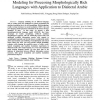Free Online Productivity Tools
i2Speak
i2Symbol
i2OCR
iTex2Img
iWeb2Print
iWeb2Shot
i2Type
iPdf2Split
iPdf2Merge
i2Bopomofo
i2Arabic
i2Style
i2Image
i2PDF
iLatex2Rtf
Sci2ools
TASLP
2008
2008
Joint Morphological-Lexical Language Modeling for Processing Morphologically Rich Languages With Application to Dialectal Arabic
Language modeling for an inflected language such as Arabic poses new challenges for speech recognition and machine translation due to its rich morphology. Rich morphology results in large increases in out-of-vocabulary (OOV) rate and poor language model parameter estimation in the absence of large quantities of data. In this study, we present a joint morphological-lexical language model (JMLLM) that takes advantage of Arabic morphology. JMLLM combines morphological segments with the underlying lexical items and additional available information sources with regards to morphological segments and lexical items in a single joint model. Joint representation and modeling of morphological and lexical items reduces the OOV rate and provides smooth probability estimates while keeping the predictive power of whole words. Speech recognition and machine translation experiments in dialectal-Arabic show improvements over word and morpheme based trigram language models. We also show that as the tight...
| Added | 15 Dec 2010 |
| Updated | 15 Dec 2010 |
| Type | Journal |
| Year | 2008 |
| Where | TASLP |
| Authors | Ruhi Sarikaya, Mohamed Afify, Yonggang Deng, Hakan Erdogan, Yuqing Gao |
Comments (0)

